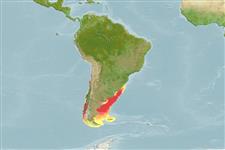Elasmobranchi (squali e razze) (sharks and rays) >
Torpediniformes (Electric rays) >
Narcinidae (Numbfishes)
Etymology: Discopyge: Greek, diskos = disc shape + Greek, pyge = tail (Ref. 45335).
More on author: Heckel.
Environment: milieu / climate zone / depth range / distribution range
Ecologia
marino demersale; distribuzione batimetrica 5 - 165 m (Ref. 38391). Subtropical; 15°S - 56°S, 76°W - 50°W (Ref. 114953)
Southeast Pacific: Peru and Chile (Ref. 5530). Southwest Atlantic: Uruguay and Argentina (Ref. 2806).
Size / Peso / Age
Maturity: Lm ? range ? - ? cm
Max length : 53.8 cm TL maschio/sesso non determinato; (Ref. 38391); 44.2 cm TL (female); common length : 42.0 cm TL maschio/sesso non determinato; (Ref. 114953)
A benthic species found on continental shelf. Produces 2-5 pups during each gestation (up to 12 reported from Argentina). Segregates by sex. Maturity size for males at 23-29 cm TL, females probably smaller (at least in Argentina); birth size at 8-9 cm TL (Ref. 114953).
Life cycle and mating behavior
Maturità | Riproduzione | Deposizione | Uova | Fecundity | Larve
Menni, R.C., R.A. Ringuelet and R.H. Aramburu, 1984. Peces marinos de la Argentina y Uruguay. Editorial Hemisferio Sur S.A. Buenos, Aires, Argentina. 359 p. (Ref. 2806)
IUCN Red List Status (Ref. 130435)
Human uses
Pesca: di nessun interesse
Informazioni ulteriori
Age/SizeAccrescimentoLength-weightLength-lengthLength-frequenciesMorfometriaMorfologiaLarveDinamica popolazioni larvaliReclutamentoAbbondanzaBRUVS
CollaboratoriImmaginiStamps, Coins Misc.SuoniCiguateraVelocitàModalità di nuotoArea branchialeOtolithsCervelliVista
Strumenti
Special reports
Download XML
Fonti Internet
Estimates based on models
Preferred temperature (Ref.
123201): 7.3 - 14.9, mean 10.4 °C (based on 197 cells).
Phylogenetic diversity index (Ref.
82804): PD
50 = 0.7500 [Uniqueness, from 0.5 = low to 2.0 = high].
Bayesian length-weight: a=0.01175 (0.00476 - 0.02897), b=2.88 (2.66 - 3.10), in cm total length, based on LWR estimates for this (Sub)family-body shape (Ref.
93245).
Trophic level (Ref.
69278): 3.3 ±0.4 se; based on size and trophs of closest relatives
Resilienza (Ref.
120179): Basso, tempo minimo di raddoppiamento della popolazione 4.5 - 14 anni (Assuming fecundity<100).
Fishing Vulnerability (Ref.
59153): Moderate vulnerability (42 of 100).
Nutrients (Ref.
124155): Calcium = 16.4 [2.1, 336.5] mg/100g; Iron = 0.857 [0.082, 10.406] mg/100g; Protein = 14.6 [10.6, 20.1] %; Omega3 = 0.27 [0.10, 0.74] g/100g; Selenium = 29 [5, 136] μg/100g; VitaminA = 5.81 [0.46, 69.02] μg/100g; Zinc = 0.792 [0.054, 9.133] mg/100g (wet weight); based on
nutrient studies. 